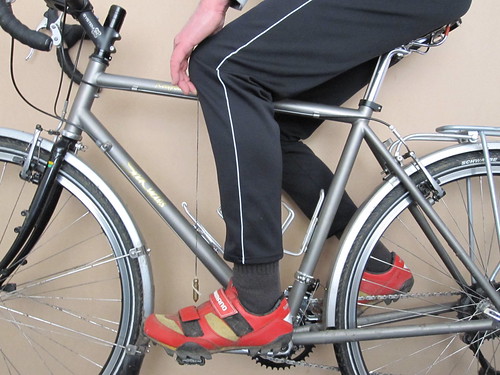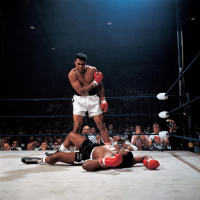What is the correct saddle height for my measurements?
velodedo
Posts: 20
There are many formulas for calculating saddle height but few clear explanations, I would like your opinion
In your opinion, what is the right saddle height for my measurements?
My measurements are:
Height 176cm
Inseam 82,7cm
Torso length 60cm
Shoulder width 42cm
Foot measurement (EU) = 45 (28.7cm)
73cm? 74,2cm? other?
Is the foot size (Small or Big) important for calculating saddle height? how? or does it have any relevance?
What should you consider for saddle height? the measurement from the center movement to the top of the saddle following the pier tube? Or the measure from the center movement to the top of the saddle where the width is 7.2cm? (anatomical saddle center)
In your opinion, what is the right saddle height for my measurements?
My measurements are:
Height 176cm
Inseam 82,7cm
Torso length 60cm
Shoulder width 42cm
Foot measurement (EU) = 45 (28.7cm)
73cm? 74,2cm? other?
Is the foot size (Small or Big) important for calculating saddle height? how? or does it have any relevance?
What should you consider for saddle height? the measurement from the center movement to the top of the saddle following the pier tube? Or the measure from the center movement to the top of the saddle where the width is 7.2cm? (anatomical saddle center)
0
Comments
-
I've never bothere measuring - I just go with trial and error. So basically your leg should have a bit of bend at the bottom of the pedal stroke. I don;t obsess over this - I'm sure you move about in the saddle so to get it millimetre right sounds OTT to me. Also I'd be amazed if your legs were exactly the same length.0
-
Fenix wrote:I've never bothere measuring - I just go with trial and error. So basically your leg should have a bit of bend at the bottom of the pedal stroke. I don;t obsess over this - I'm sure you move about in the saddle so to get it millimetre right sounds OTT to me. Also I'd be amazed if your legs were exactly the same length.
Ok but what you say is correct but I was interested in having a starting idea on the correct height saddle height and how to measure on the bike0 -
Very similar to me, 178cm tall and ~83cm cycling inseam (not trouser inseam, which is ~77cm). Short legs and long torso for someone that tall.
I use ~89.5-90.5cm from pedal top to top of saddle (using a hardback book to extend saddle top surface so I'm measuring parallel to the seat tube), running along the seat tube. Measuring this way accounts for the small difference in crank length between the Voodoo and Cube, that use 175mm and 172.5mm cranks respectively (latter clipless, former usually flat pedals).
The 1.09 method, basically.================
2020 Voodoo Marasa
2017 Cube Attain GTC Pro Disc 2016
2016 Voodoo Wazoo0 -
NitrousOxide wrote:Very similar to me, 178cm tall and ~83cm cycling inseam (not trouser inseam, which is ~77cm). Short legs and long torso for someone that tall.
I use ~89.5-90.5cm from pedal top to top of saddle (using a hardback book to extend saddle top surface so I'm measuring parallel to the seat tube), running along the seat tube. Measuring this way accounts for the small difference in crank length between the Voodoo and Cube, that use 175mm and 172.5mm cranks respectively (latter clipless, former usually flat pedals).
So your saddle height measured from the center movement is
90.5-17.25 = 73.25cm?
I have very big feet ... measure 45 (eu)0 -
velodedo wrote:NitrousOxide wrote:Very similar to me, 178cm tall and ~83cm cycling inseam (not trouser inseam, which is ~77cm). Short legs and long torso for someone that tall.
I use ~89.5-90.5cm from pedal top to top of saddle (using a hardback book to extend saddle top surface so I'm measuring parallel to the seat tube), running along the seat tube. Measuring this way accounts for the small difference in crank length between the Voodoo and Cube, that use 175mm and 172.5mm cranks respectively (latter clipless, former usually flat pedals).
So your saddle height measured from the center movement is
90.5-17.25 = 73.25cm?
I have very big feet ... measure 45 (eu)
Yes ~73.25cm on my Cube.
Your feet size won't affect the seat height. ================
================
2020 Voodoo Marasa
2017 Cube Attain GTC Pro Disc 2016
2016 Voodoo Wazoo0 -
Fenix wrote:I've never bothere measuring - I just go with trial and error. So basically your leg should have a bit of bend at the bottom of the pedal stroke. I don;t obsess over this - I'm sure you move about in the saddle so to get it millimetre right sounds OTT to me. Also I'd be amazed if your legs were exactly the same length.
This- there are so many individual variables that trial and error is the only way to go my my opinion.Postby team47b » Sun Jun 28, 2015 11:53 am
De Sisti wrote:
This is one of the silliest threads I've come across.
Recognition at last Matthew, well done!, a justified honour smithy21 wrote:
smithy21 wrote:
He's right you know.0 -
Your leg should be basically straight with your heel on the pedal, knee will be slightly kinked with your feet in the right position.I don't do smileys.
There is no secret ingredient - Kung Fu Panda
London Calling on Facebook
Parktools0 -
I've found the heel on pedal method works well for me.0
-
+1 Shortfall0
-
cooldad wrote:Your leg should be basically straight with your heel on the pedal, knee will be slightly kinked with your feet in the right position.
As above. Any kind of scientific 'leg length' formula is doomed to fail anyway, as various different cleat/pedal/shoe combinations will always give you a different stack height regardless. 'Heel on pedal' will get you in the ballpark, so just make minor adjustments from there.0 -
Another one for this. It gets you pretty damned close if not spot on, you can fiddle with it from there if you feel the need.cooldad wrote:Your leg should be basically straight with your heel on the pedal, knee will be slightly kinked with your feet in the right position.0 -
Also depends on crank length, the lemond method of .885 from BB is based on 175 mm cranks, my MTB has them on comes spot on for heel on pedal and calculation giving the same result,My road bikes have 170 mm cranks and adding 5 mm to saddle height gives the same heel on pedal reach.FCN 3/5/90
-
In my opinion, the lemond formula can not be used today because the technologies (shoes, pedals, frames) have changed0
-
velodedo wrote:In my opinion, the lemond formula can not be used today because the technologies (shoes, pedals, frames) have changed
No technology has changed significantly to the point where it alters any of the biomechanical relationships involved, or the Lemond formula itself. The only question is whether you choose to follow the Lemond formula, rather than any of the other multitude of formulas for establishing saddle height. As others have already said, simply placing your heel on the pedal with your leg extended will get you near enough to the point where the only other changes you need will be fractional and based on personal preference.0 -
Imposter wrote:velodedo wrote:In my opinion, the lemond formula can not be used today because the technologies (shoes, pedals, frames) have changed
No technology has changed significantly to the point where it alters any of the biomechanical relationships involved, or the Lemond formula itself. The only question is whether you choose to follow the Lemond formula, rather than any of the other multitude of formulas for establishing saddle height. As others have already said, simply placing your heel on the pedal with your leg extended will get you near enough to the point where the only other changes you need will be fractional and based on personal preference.
There is a lot of confusion, for example some biomechanics say that the saddle height is measured starting from the center movement and reaching the top of the saddle where it is wide 7.2cm (corresponds to the anatomic center) while it was said that it was biosgnava to measure it following the piantone tube , between the two types of measurements there are a few mm of difference ... what is the right method?
For example, the height of the delta pedals used by Lemond was 8mm higher than the shimano pedals used today0 -
velodedo wrote:Imposter wrote:velodedo wrote:In my opinion, the lemond formula can not be used today because the technologies (shoes, pedals, frames) have changed
No technology has changed significantly to the point where it alters any of the biomechanical relationships involved, or the Lemond formula itself. The only question is whether you choose to follow the Lemond formula, rather than any of the other multitude of formulas for establishing saddle height. As others have already said, simply placing your heel on the pedal with your leg extended will get you near enough to the point where the only other changes you need will be fractional and based on personal preference.
There is a lot of confusion, for example some biomechanics say that the saddle height is measured starting from the center movement and reaching the top of the saddle where it is wide 7.2cm (corresponds to the anatomic center) while it was said that it was biosgnava to measure it following the piantone tube , between the two types of measurements there are a few mm of difference ... what is the right method?
For example, the height of the delta pedals used by Lemond was 8mm higher than the shimano pedals used today
At the risk of repeating myself - just follow the heel on pedal method as suggested earlier. Not sure why you feel the need to over-complicate something which is actually very, very simple.0 -
biosgnava?
piantone tube?
Are those even words?I don't do smileys.
There is no secret ingredient - Kung Fu Panda
London Calling on Facebook
Parktools0 -
Tube is a word, not sure about the others. One might be a pasta sauce.cooldad wrote:biosgnava?
piantone tube?
Are those even words?
As Imposter says, don't over complicate things it's really not that hard.
If you use all the measurements and data to set your saddle height and it feels wrong what would you do? Persevere because the numbers say it's correct or adjust it a bit? Leg straight, heel on pedal to set it up then go for a ride. If it feels wrong adjust it. Takes no time at all.0 -
With the head method, are you putting the crank in line with the seat tube, or putting the crank at 6 o'clock?
I used to do the former for ages, then read it supposedly is based on latter, not that it alters things massively.================
2020 Voodoo Marasa
2017 Cube Attain GTC Pro Disc 2016
2016 Voodoo Wazoo0 -
According to my calc's it should be 1500 miles. Wait maybe I hit the wrong button. In any case no one here really knows. How could they? You have to find this out for yourself.0
-
Sorting the height is pretty simple with the heel method but what about seat position on the rails? Does this require some advanced trigonometry to work out?!0
-
Maglia_Rosa wrote:Sorting the height is pretty simple with the heel method but what about seat position on the rails? Does this require some advanced trigonometry to work out?!
As we are all pros, the saddle tip must be at least 5cm behind the vertical plane of the BB centre. ================
================
2020 Voodoo Marasa
2017 Cube Attain GTC Pro Disc 2016
2016 Voodoo Wazoo0 -
Is the heal method done with shoes on?
Surely the thickness of the heal compared to the sole-plate makes a difference here?
Relatively flat shoes would leave the saddle too low where as higher healed shoes would put it too high.
Just ride the bike: if your knees hurt at the back of the leg the saddle is too high, if they hurt at the front its too low.
If you are pain free after a 100 miler it's probably ok.0 -
Haha !,NitrousOxide wrote:Maglia_Rosa wrote:Sorting the height is pretty simple with the heel method but what about seat position on the rails? Does this require some advanced trigonometry to work out?!
As we are all pros, the saddle tip must be at least 5cm behind the vertical plane of the BB centre.
I like
Ok unless your ( like me ) a short arse , 4 cm is pushing it for me and i have run it at 3 cm before now .FCN 3/5/90 -
KOPS is a starting point , some may agree or disagree and like everything its subject to what feels right for youMaglia_Rosa wrote:Sorting the height is pretty simple with the heel method but what about seat position on the rails? Does this require some advanced trigonometry to work out?! FCN 3/5/90
FCN 3/5/90 -
There is a UCI exemption for people like you and me especially if you have short femurs, so the 5cm rule always applies except when it doesn’tcyberknight wrote:
Haha !,NitrousOxide wrote:Maglia_Rosa wrote:Sorting the height is pretty simple with the heel method but what about seat position on the rails? Does this require some advanced trigonometry to work out?!
As we are all pros, the saddle tip must be at least 5cm behind the vertical plane of the BB centre.
I like
Ok unless your ( like me ) a short ars* , 4 cm is pushing it for me and i have run it at 3 cm before now . 0
0 -
I found this document really informative and useful for both saddle height and fore/aft position. I did my own bike fit using it plus the Bike Fast Fit app on my iPhone.
http://bikedynamics.co.uk/shop.htm0 -
Being rather long in the tooth, my method:
1, Heel straight leg for saddle height
2, position of saddle on rails, finger tips brushing the handlebars, elbow just touching the point of the saddle.
Crikey does sound simplistic in comparison with the current indulgence with precision.
Oh mustn't forget..... Check it in shop windows as you ride past, as in so many things if it looks right it is probably right!
Covered lots of racing and training miles using those criteria.0 -
darkhairedlord wrote:Is the heal method done with shoes on?
Surely the thickness of the heal compared to the sole-plate makes a difference here?
Relatively flat shoes would leave the saddle too low where as higher healed shoes would put it too high.
That's why it's only a 'ball park' measurement, which needs fine-tuning. It's never going to give you an 'exact' measurement, but then nothing else will either..0



